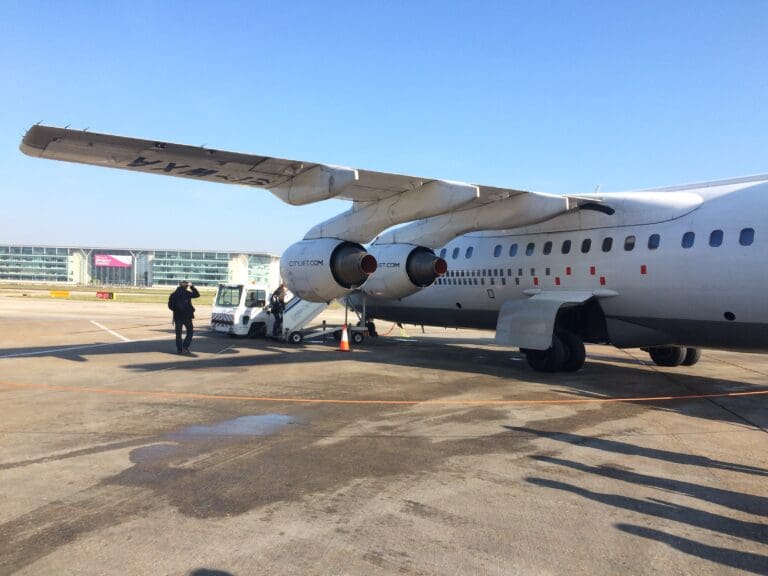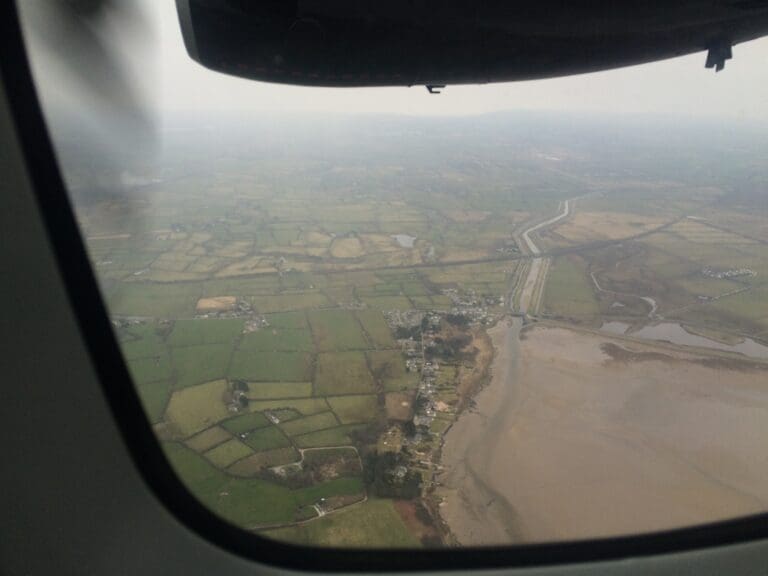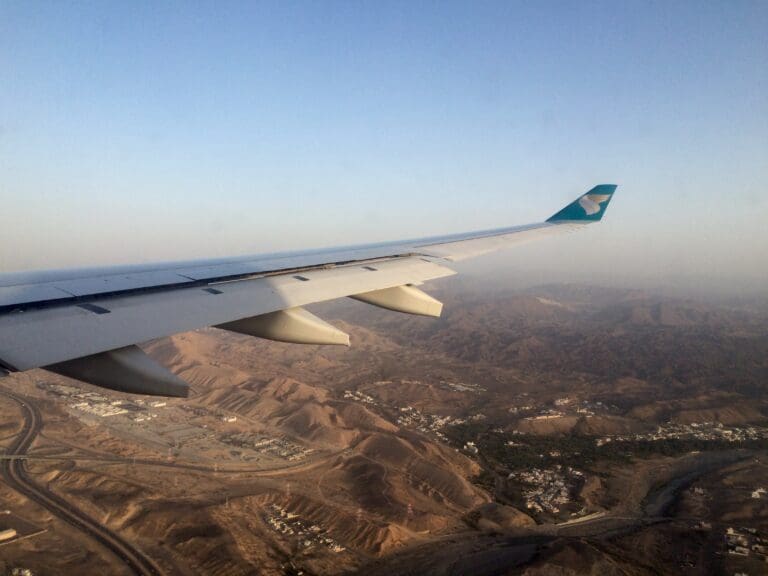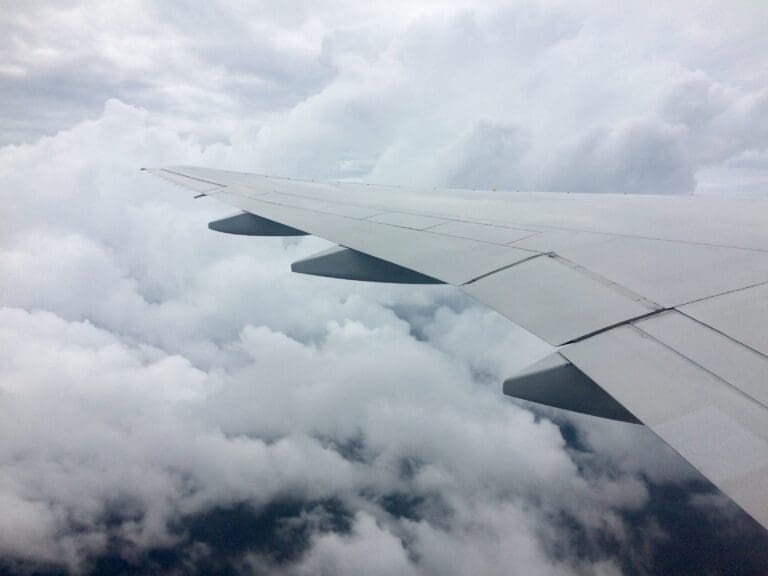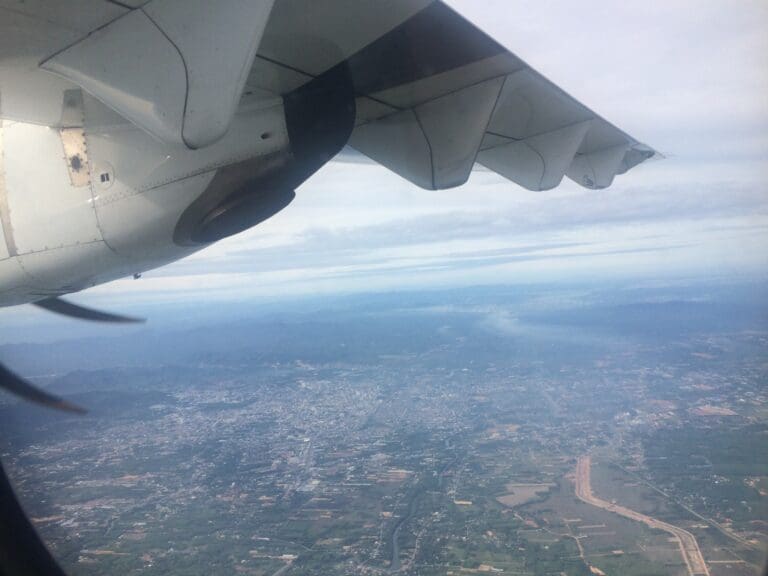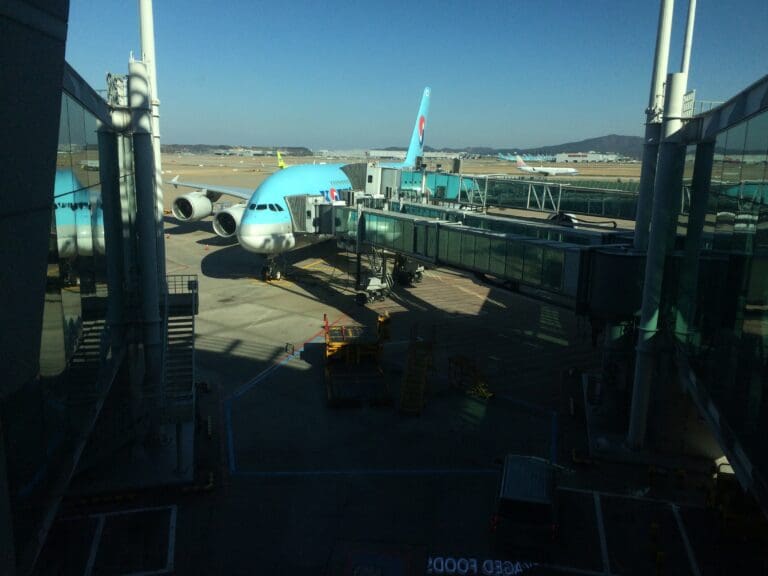Sampling the Low Cost German Giant: Manchester to Dusseldorf with Eurowings

Background
Having fallen victim to a bargain Middle East Airlines fare from Paris CDG to Dubai via Beirut, yet finding myself in my hometown of Sheffield after completing a work contract in the French capital, I needed to find a cost-effective way of positioning myself back to Paris to catch my flight to Dubai.
In the usual manner, my first point of call was Skyscanner, where I searched for flights from Birmingham and Manchester to the French capital. With Air France and Flybe both flying multiple daily services between both cities and Paris (plus EasyJet from Manchester), I most certainly did not face any shortage of flights. However, with my departure day falling within the February half term holiday, cheap flights at sensible times were virtually non-existent, so I turned to browse alternative options. Being a European aviation enthusiast, I have long respected (and been envious of) Germany’s well-developed spotting facilities, with many German airports graced with the luxury of an observation deck. Despite not being the optimal season to spend a day out at one of Germany’s fine airport terraces, I made it my mission to work in a spotting session into my itinerary whilst paying less than the total for a direct flight to Paris. To make this possible, I would have to find a cheap early morning flight to a German city and a cheap flight or train ticket to Paris that evening. Having initially focused on Berlin, Cologne and Dusseldorf, the latter was soon crowned the winner thanks to cheap morning flights from Manchester and cheap evening rail services to Paris.
With Eurowings and Flybe offering several flights flights between Manchester and Dusseldorf each day, the route is well served. Having had a wide-ranging set of experiences with Flybe and a largely positive experience on my four previous flights with Eurowings, whilst open to flying with either, I leaned more towards the German low-cost carrier. As it happened, Eurowings proved to be the far cheaper option and so I headed over to their website. Upon landing at the airline’s homepage where I was presented with a trio of advertisements – one for the airline’s service between Birmingham and Vienna, another reminding me of Eurowings’ knowledge of my search history, presenting me with ‘My last search’ – a flight from Paris to Manchester via Dusseldorf as well as an advertisement for the 20% early bird discounted fares. With little delay, I moved on to the search engine and was soon presented with the four direct Eurowings flights from Manchester that Thursday, with these operated by two Airbus A319s, an Airbus A320 and an LGW-operated Dash 8 Q400. Whilst I would have preferred making the journey onboard the latter type, I settled on the earliest and cheapest option – the Airbus A320 service departing at 0805. After selecting this flight I was presented with Eurowings’ three fare options – Basic, Smart and BIZclass, these priced at £34.99, £55.99 and £104.99 respectively. Including 23kg of hold luggage, free seat reservation in the rear half of the aircraft and priority boarding, I settled on the Smart fare before moving onto the ‘More services’ page. On this page, I was given the option of adding a 33kg bag for £44, alongside oversized luggage, special assistance and of course seat selection. I skipped past all options bar the latter, selecting Seat 19F for the journey over to Dusseldorf, which, in the unlikely event of cloudless skies would allow me good views of my hometown of Sheffield during the climb. Once I had selected my seat, I moved onto the payment page and paid the £55.99 for the flight without any glitch, soon receiving my confirmation of this in German only via email.
Once the booking was done, all that was left to do was work out how I would get from Sheffield to Manchester Airport with enough time to drop off my suitcase and work my way through Terminal 2 at a leisurely pace. Thankfully, Transpennine Express operates direct services from Sheffield to Manchester Airport with the first service of the day departing at 0324. Viewing this to be a little too early, I instead booked a seat on the 0509 service, which was scheduled to reach Manchester Airport at 0627. Having already selected my seat, and, needing to visit the check-in counters to drop off my bag, there was no great need to check-in online before my flight. Nevertheless, I decided to do this and checked in quickly and painlessly via Eurowings’ app.
The Journey
At the ungodly hour of 0400, my phone buzzed and I awoke from a short sleep. After a quick shower and coffee, I gathered my belongings and ordered an Uber to take me to Sheffield Station. Fortunately, with plenty of taxis available, I didn’t have to wait long and several minutes later, a Honda pulled up outside ready to whisk me off to the station.
At busy times, the journey to Sheffield Station from my parents’ house can take up to 20 minutes, however, with few cars on the early morning streets, this took exactly nine minutes. Upon arriving there, seeing as the station’s shops and cafés were yet to open, I made a beeline for the platform where the TransPennine Express Class 185 diesel multiple unit could already be seen waiting to make the journey across the Peak District to Manchester. As I had expected, judging by the number of suitcase-carrying passengers, the majority of those taking the early morning service were bound for the airport. Thankfully there was plenty of space on board for both passengers and their luggage.


With a relatively tight schedule, at 0509 I was pleased to hear the closing beep of the doors before our train pulled away from Sheffield Station. A short while later, the train sped west through the Peak District National Park, the morning darkness preventing any views of what is often regarded as one of Britain’s most spectacular rail journeys. With no unscheduled stops during the journey, the train pulled into its penultimate stop, Manchester Piccadilly on time where more suitcase-wielding passengers plus a few airport staff boarded. There, the train reversed and after a few minutes, the train commenced its short sprint southwards to Manchester Airport. Much to my delight, the train pulled into the station two minutes ahead of schedule by which time many of those onboard were already waiting at the doors, all eager to escape and thus giving the impression they were late for their flights! After leisurely disembarking the train, I voyaged up the escalators and through the ticket barriers before commencing my walk to the terminal.
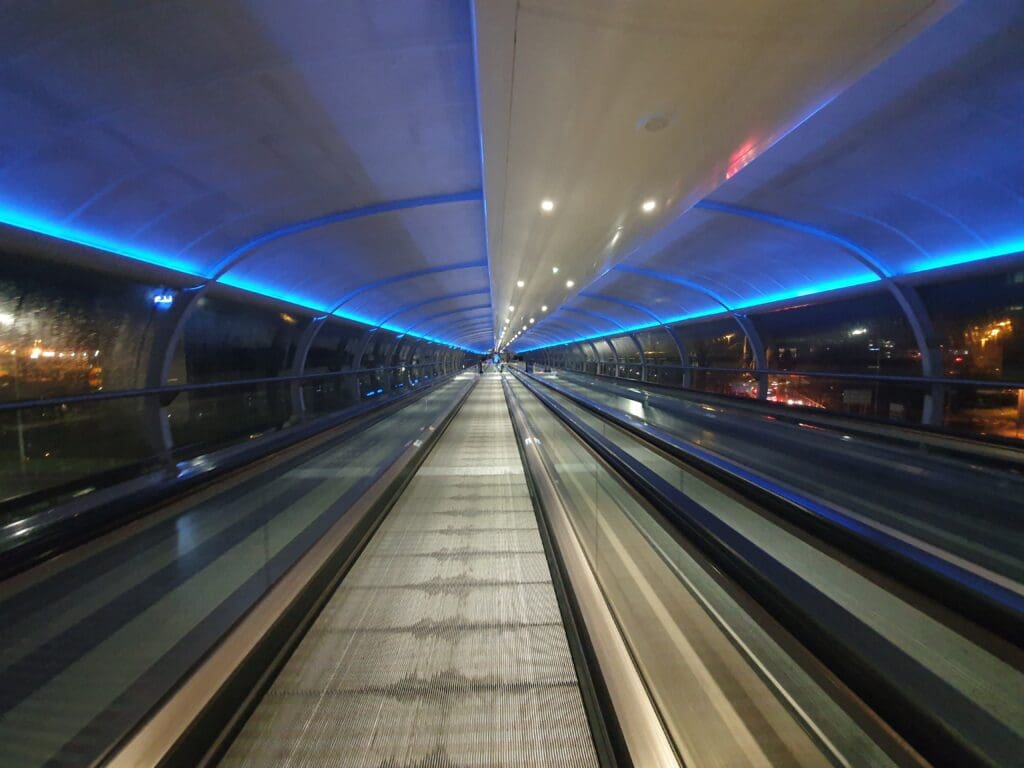
Linked to all terminals by a series of elevated tubes officially known as the ‘Skylink’, reaching Terminal 2 from the station was by no means a difficult task and within five minutes I found myself in the terminal’s large and slightly dated-looking check-in hall. With plenty of flights departing from the terminal that morning, landside, the terminal was rather busy with plenty of long queues visible at many of the check-in desks. Whilst not late, I did not have a great deal of time to spare, so I headed straight to the three check-in desks dedicated to dealing with Eurowings’ passengers. Seeing as the 0805 flight to Dusseldorf was Eurowings’ only departure until 1205 and the fact that many of those on the flight were travelling on business with hand luggage only and already armed with a boarding pass, the check-in desks were virtually empty. With a grand total of three passengers milling around these, I was able to walk straight up to a desk. Within moments of handing over my passport to the friendly check-in agent and placing my bag on the belt, a luggage tag was printed off and my bag was sent on its way. As soon as this procedure was complete, the staff member advised me to head upstairs to the security check immediately.
As I neared the top of the stairs, I caught sight of the queues which stretched as far as the eye could see and I immediately realised why the agent had encouraged me to head to security as soon as I could. Wasting no time, I joined the long snaking queue, arriving at the boarding pass gates within about five minutes, with the wait to reach a checkpoint taking a further 15 minutes. Despite the queues, all checkpoints were open, and I was pleased to find that all staff members were polite, friendly and worked efficiently. Whilst it is very common to see signs noting of the prohibition of mobile phone usage whilst queueing at airport security checkpoints, that day this was the first time that I had witnessed this being policed in the UK, with one member of staff making sure that nobody used their phones. By around 0700, I had passed through the security checkpoint with no need for additional checks and was free to continue onwards and explore the sights of the airside portion of the terminal.
As is the norm at most British airports, once through security passengers are forced to take a winding route march through duty free. Seeing as I did not need to purchase any souvenirs related to the two local football teams, nor did I have any cravings for any large tubes of M&Ms, I steamed through this and soon arrived in the main airside area.
As had been the case with the landside portion of the terminal, airside, Terminal 2 appeared to be a little dated in its design and was rather crowded. However, as I wandered around I did stumble across plenty of empty seats down the terminal’s two piers. When it comes to destinations and airline diversity, Terminal 2 wins the gold medal amongst all three terminals and serves as the starting point for many of Manchester’s long-haul services, alongside a plethora of short and medium-haul routes. That morning, if I had not wished to fly to Dusseldorf, I could have headed to Doha, Hong Kong, Newark, or Singapore instead. Meanwhile, Jet2 and TUI Airways, whose operations are based in the terminal, serve an array of destinations across Europe.
With its dated interior and lack of any notable architectural or stylish features, it may perhaps be reasonable to conclude that Terminal 2 is not particularly memorable. However, this does serve its purpose and aside from the long queues, I was not left with any major complaints. Whilst busy, the terminal appeared to be clean and tidy. Plus, beating some other airports, fast complimentary wifi was provided, whilst plug sockets and USB-A ports could be seen throughout the airside area. For those with some time to spare, the terminal is not short of bars, cafés, restaurants and shops, with these littered throughout the terminal, virtually all of which were open and incredibly busy at that time in the morning (particularly the pub!).
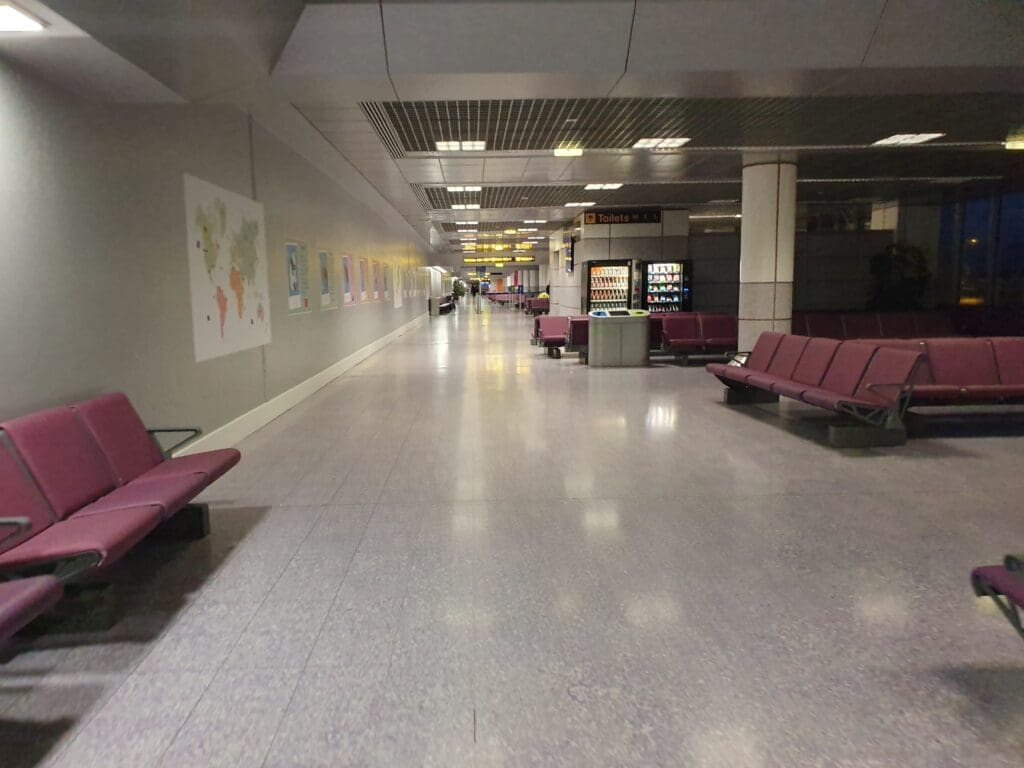
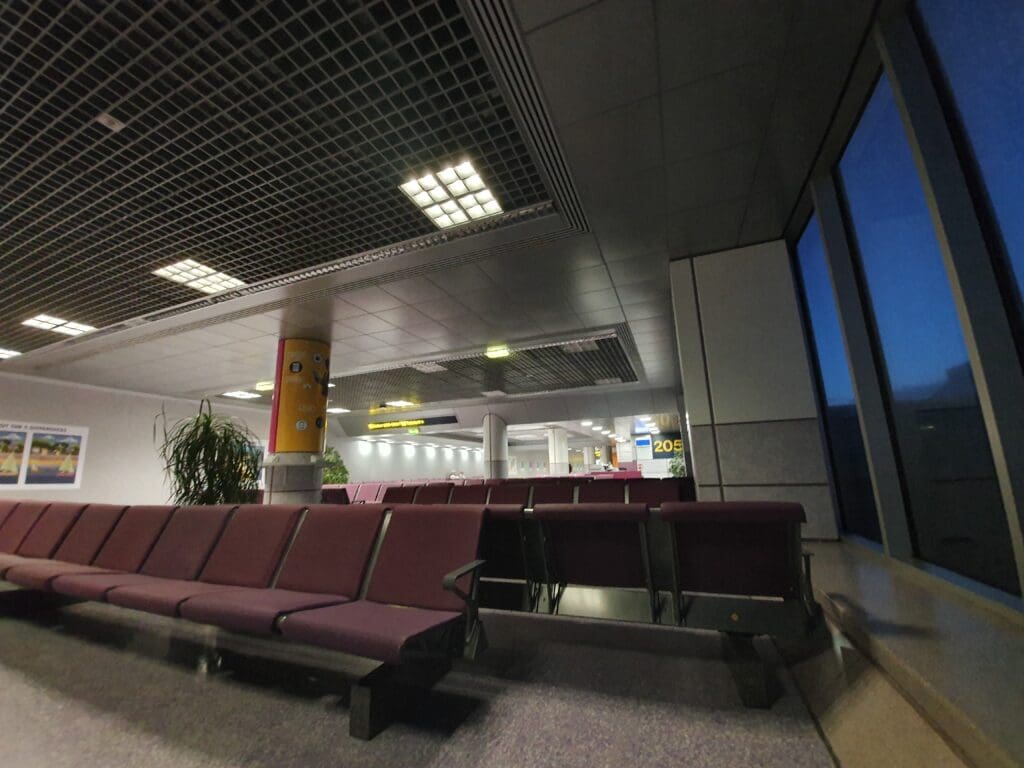
From an aviation enthusiast’s perspective, despite lacking runway vistas, large windows offer good views of almost all gates and allow for parked aircraft at many of the airport’s remote stands to be seen. However, I did find that the windows in the older portion of the terminal were in dire need of a clean. Not wanting to splash any cash, I took a seat and watched the traffic outside which included a Virgin Atlantic Boeing 747-400 resting in between flights to Orlando and a United Airlines Boeing 767-300ER arriving from Newark. Meanwhile, plenty of Jet2 and TUI Airways aircraft could also be seen.
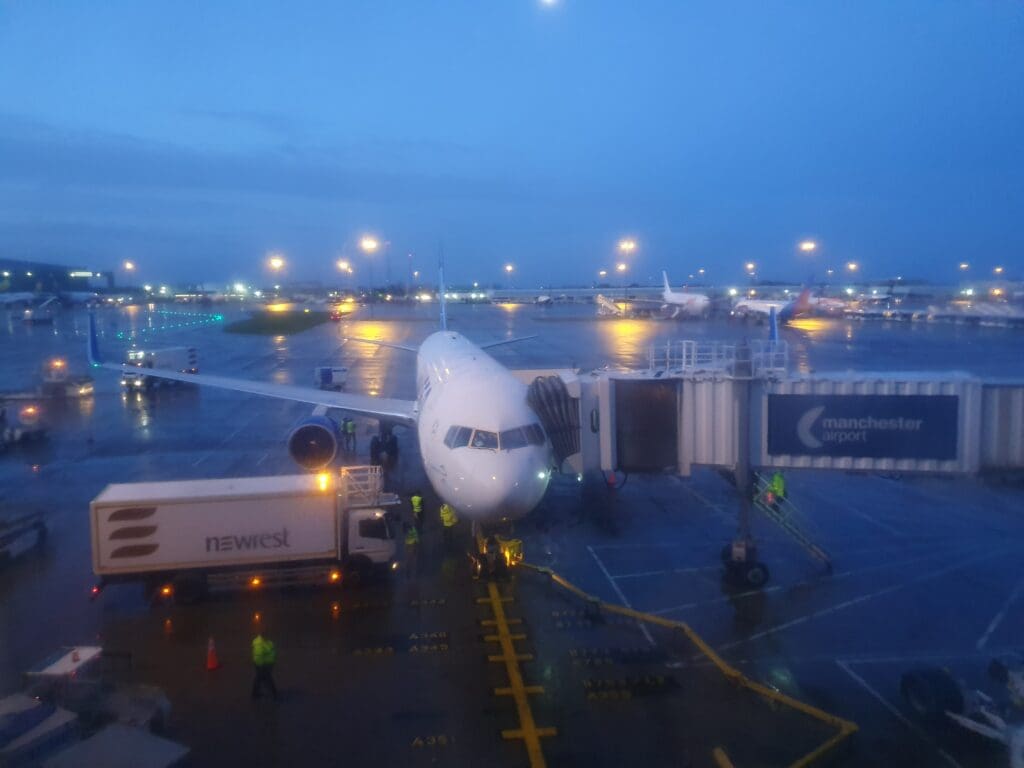
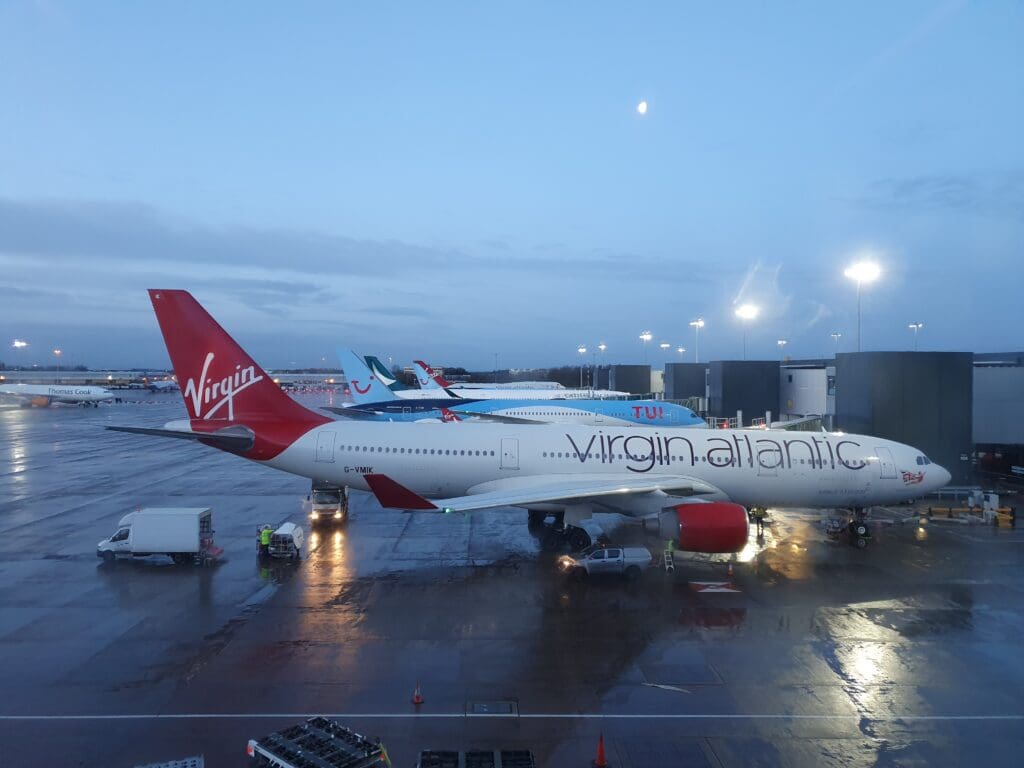
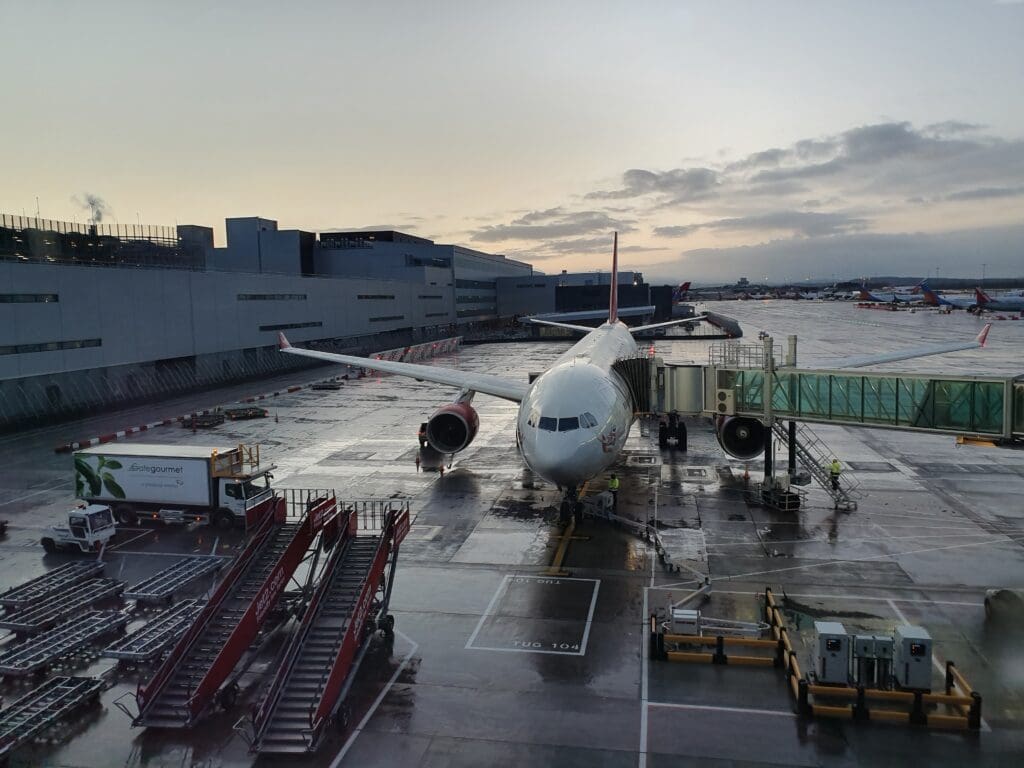
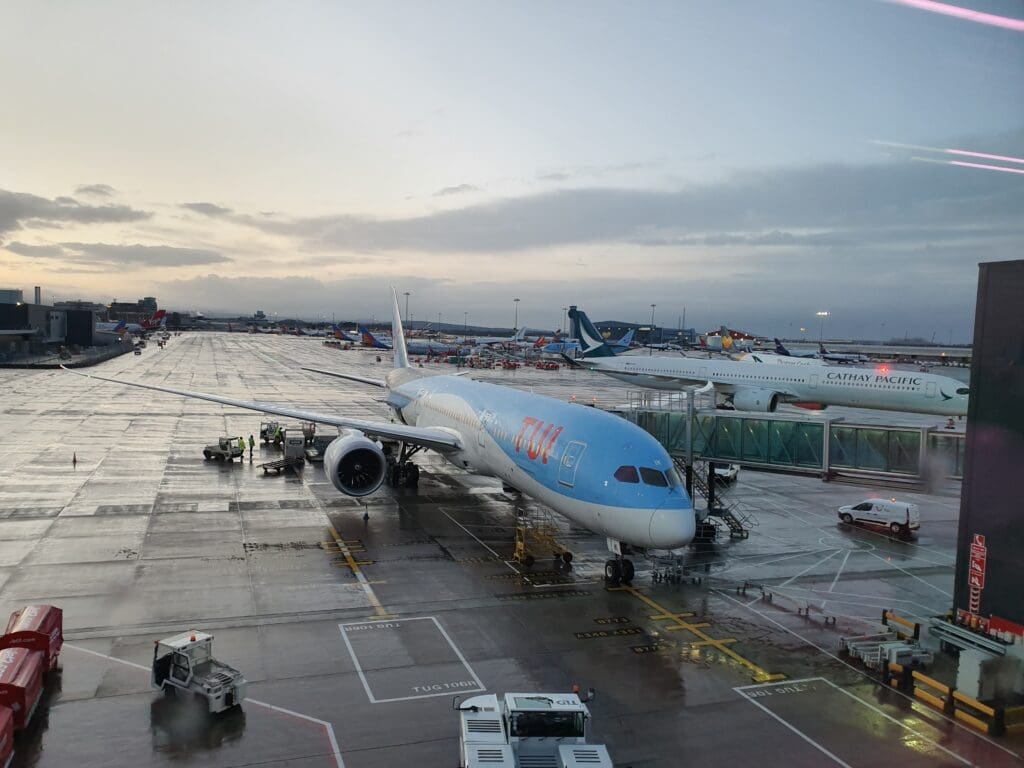

As I waited, I caught sight of the sharklet-fitted Airbus A320-214 D-AIZQ on its way to Stand 101 after operating Eurowings’ early morning hop from Dusseldorf. Almost exactly seven years old, this jet first took to the skies in late February 2013 from Airbus’ Hamburg Finkenwerder plant and was amongst the first Sharklet-fitted Airbus A320s to enter commercial service. Given away by its Lufthansa-esque ‘D-AIZ’ registration, the aircraft began its life with the German flag carrier. Interestingly, according to one Jetphotos.net photo caption, the aircraft was the first Sharklet-fitted Airbus to visit Manchester! After an almost two-year stint flying with Lufthansa, in January 2015 the aircraft was sent to Bratislava where it was repainted into colours of Eurowings before entering service with the low-cost carrier. Since then, the aircraft has primarily operated from Dusseldorf to destinations across Europe and North Africa. In the week before my flight, the aircraft operated 33 legs, connecting Dusseldorf with Athens, Berlin Tegel, Bucharest, Krakow, Manchester, Marrakech, Palma de Mallorca, Prague, Stockholm Arlanda, Vienna and Zurich, covering at least 21,000 miles in the process.
Fifteen minutes before the scheduled commencement of boarding, at 0720, the departure boards advised passengers to head to Gate A1 – located, as the name would suggest on the newly constructed ‘A’ pier. Located some way from the main area of the terminal, the walk to the gate took just under 10 minutes, however working moving walkways were offered to speed this journey up. As I neared the new pier, a host of widebody jets came into view. These included a Cathay Pacific A350-1000, a pair of TUI Airways Boeing 787-9 Dreamliners and a Virgin Atlantic Airbus A330 and Boeing 747-400. Meanwhile a line of narrowbody LCC jets – namely five Jet2 Boeing 737-800s and the Eurowings A320 were hidden on the other side of the pier. Upon arriving at the new pier, I was very pleased with the interior – this was bright, modern and pleasant and offered good views the aircraft waiting outside.
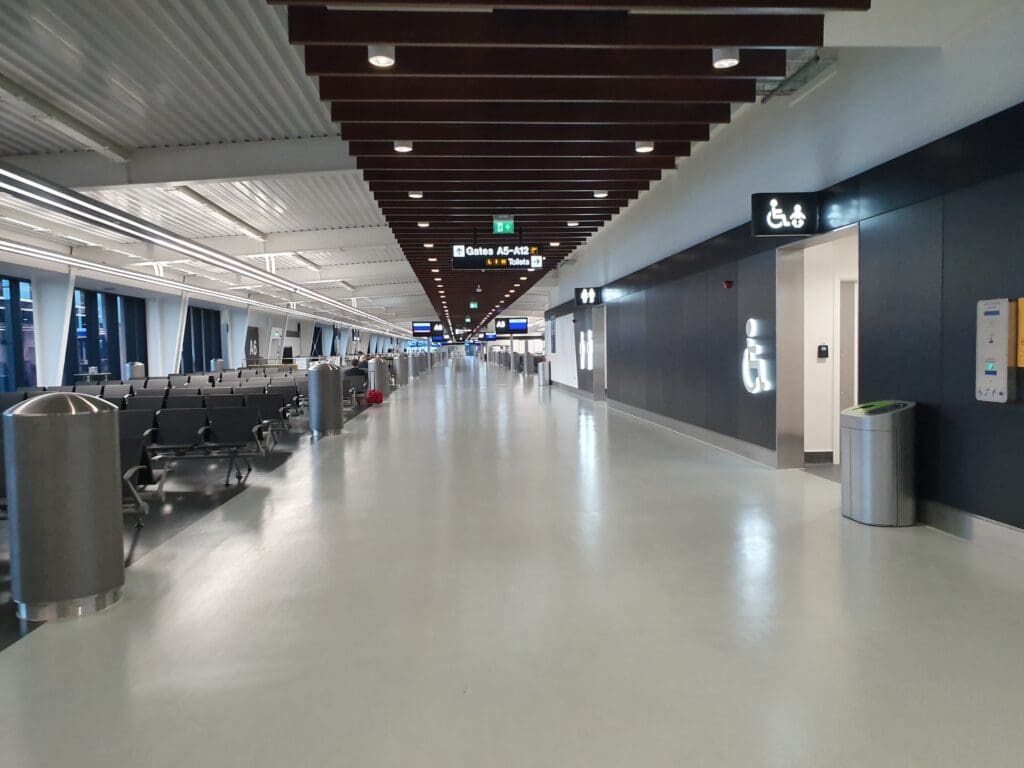
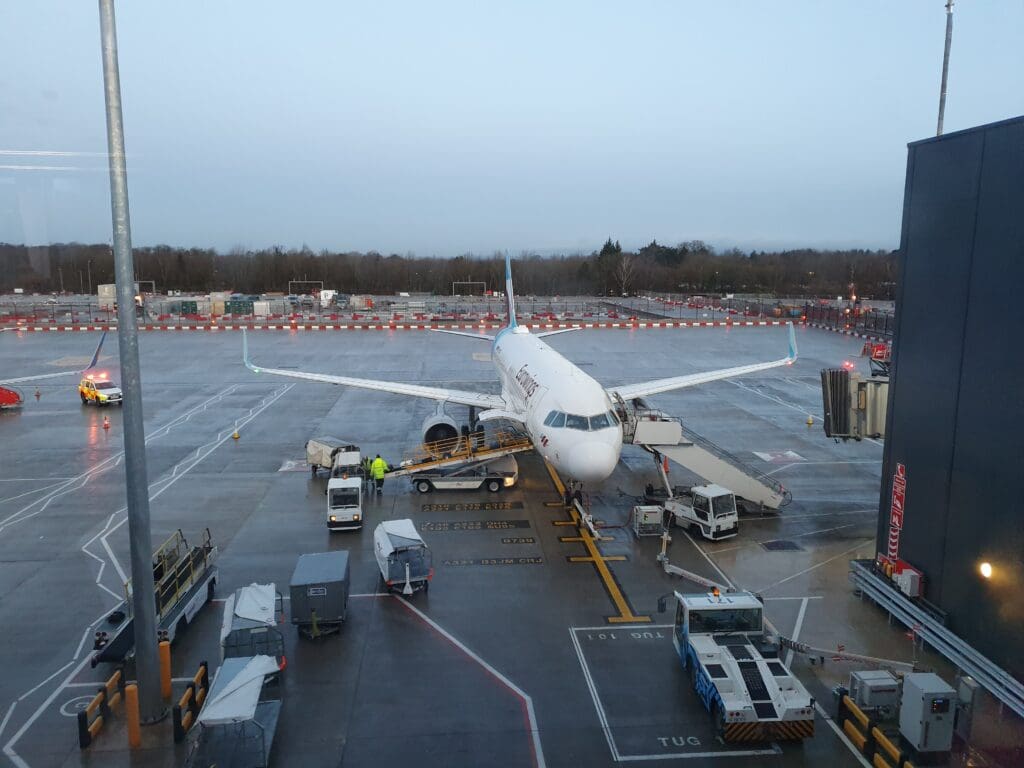
Whilst by no means late, by the time I arrived the gate was already a hive of activity with plenty of passengers eagerly waiting for boarding to commence. With little else to do, I took a seat and unintentionally eavesdropped into my neighbour’s conversations which ranged from archaeology to Love Island and just about everything in between. Meanwhile, as the clock neared the scheduled boarding time of 0735, two staff members could be seen furiously typing away. Soon enough 0735 arrived, however, boarding was not called until five minutes later at 0740. At this time, an announcement was made in the usual manner inviting those in BIZclass and those needing assistance to proceed to the counter for boarding. Moments later those passengers seated in Zone 1 were invited to board the aircraft and a queue of passengers formed almost immediately. Finding myself near the front of this queue, it did not take long until my boarding pass was scanned and passport checked before I was wished a nice flight. Whilst a jetway was present, in true LCC-style boarding would take place via steps and so a long descent was needed down several flights of steps before heading outside into the chilly winter air and making my way up the steps to the aircraft.
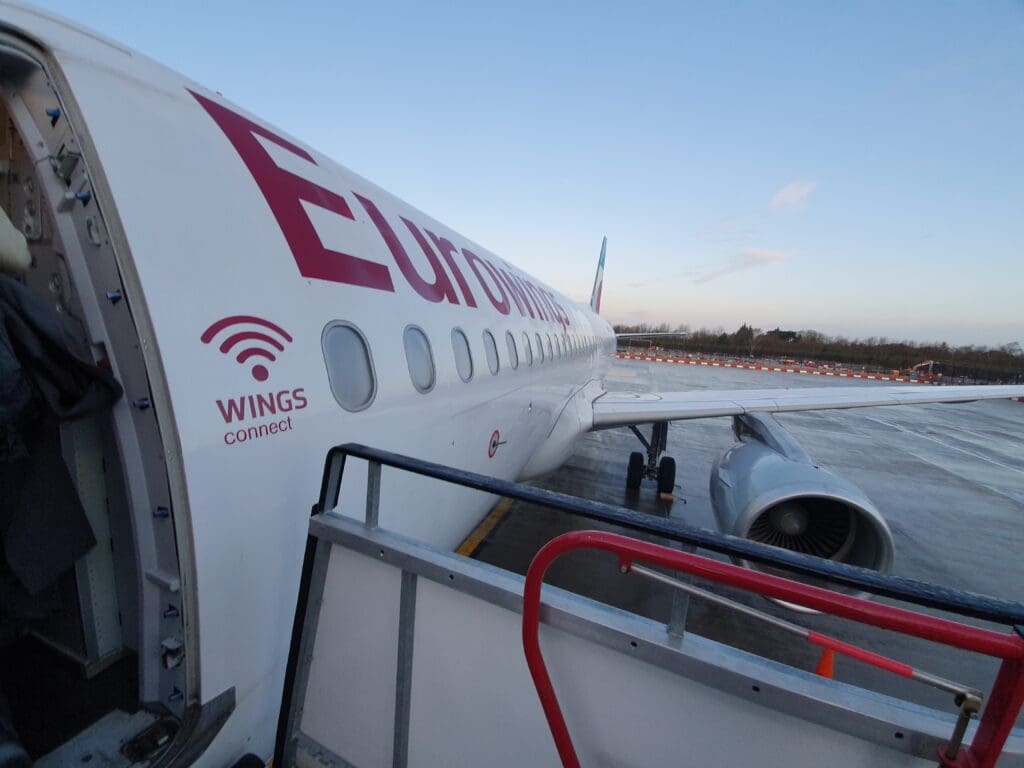
As soon as I stepped into the Airbus’ forward galley, two of the flight’s four flight attendants welcomed me with a lively greeting, serving to get my journey off to a good start. Without delay, I turned right and made my way into the aircraft’s cabin, ready to trek down the aircraft. Whilst Eurowings is somewhat of an anomaly in the European low-cost carrier market for offering something of a premium cabin, onboard there was a lack of differentiation between the BIZclass and standard Economy seats. Despite the two cabins being separated by a movable ‘BIZclass’ branded divider, this was absent that morning. Instead, these were only differentiated from the Economy seats by a red (faux?) leather headrest. After passing through the BIZclass section, I arrived in Economy.
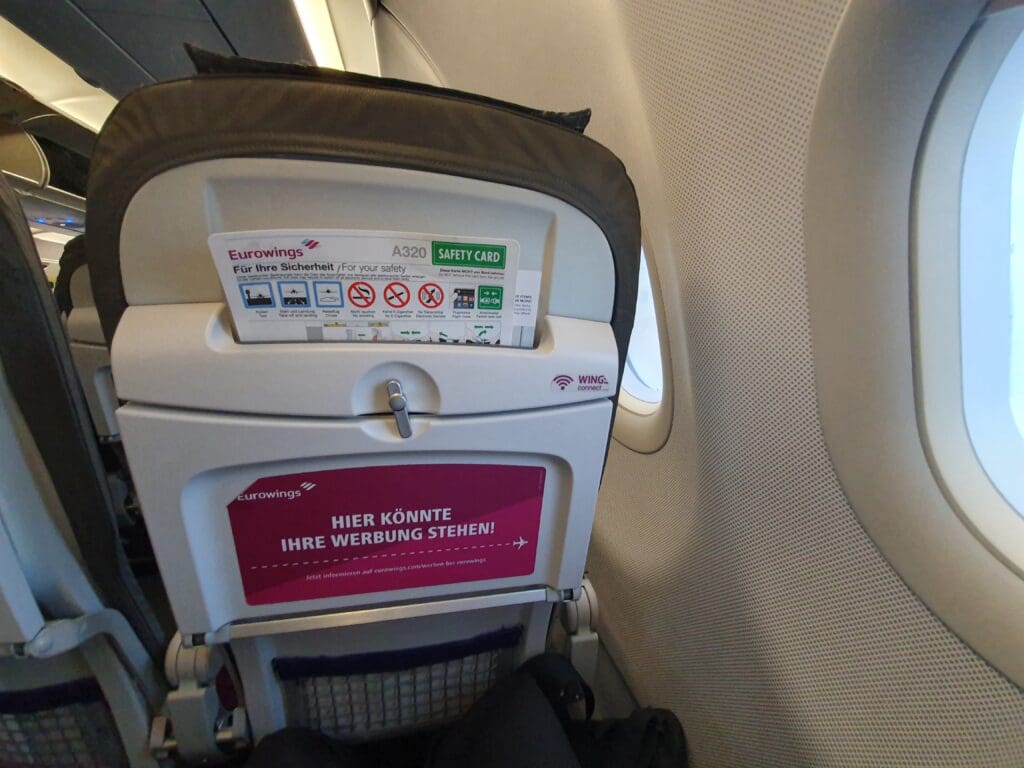

In Economy, all seats were covered in a grey pleather cover and featured a grey antimacassar adorned with Eurowings’ logo. As with those Lufthansa Airbus narrowbodies yet to receive a cabin refresh, all seats come in the form of the reasonably thin Recaro BL3520, complete with a literature compartment, tray table and seatback pocket. Unsurprisingly, unlike on the Lufthansa Group’s newer Airbuses and refurbished aircraft, no form of at-seat power was present, however, this was not needed given the length of the flight to Dusseldorf. As I neared my seat, I received another warm welcome before I stowed my things in the overhead locker. Seeing as I was yet to be joined by any seatmates, I decided to plonk my bags down and head to one of the two lavatories at the rear of the cabin. Upon opening this up, I was pleased to find this to be clean and stocked with the basics, thereby serving its important purpose without issue.
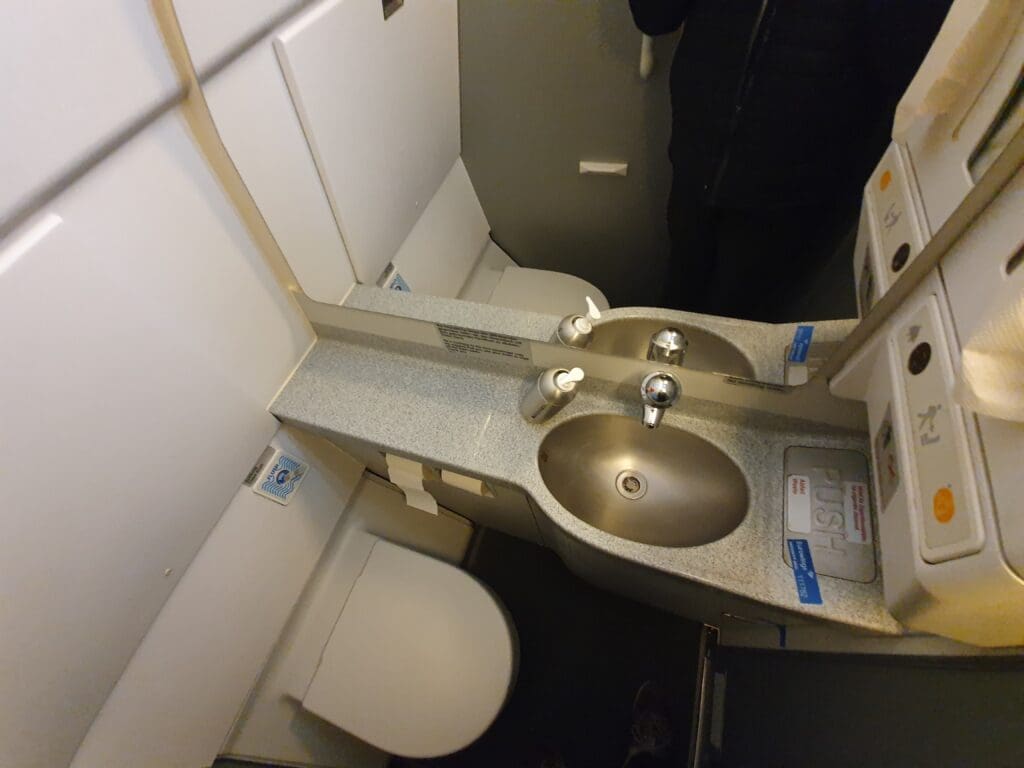
Upon returning to Seat 19F, I strapped myself in and settled in for the short journey across the North Sea. Since the aircraft’s life with Lufthansa, plenty of decals advertising an array of services could be seen across the cabin. This included a peeling sticker advertising the aircraft’s Wings Connect wifi network on the seatback, and a larger sticker on the underside of the tray table noting ‘Your advertisement could be here!’ in German. Unfortunately, when it came to comfort I found the seat to leave a lot to be desired, with the seat being firm, whilst the legroom was rather minimal. Whilst this would be tolerable given the short duration of that morning’s flight, I wouldn’t have wanted to have the (mis)fortune of travelling onboard the jet on one of its longer slogs to say the Canary Islands. Moving to the positives, the area around my seat appeared to be clean and tidy and lacked noticeable signs of wear and tear.
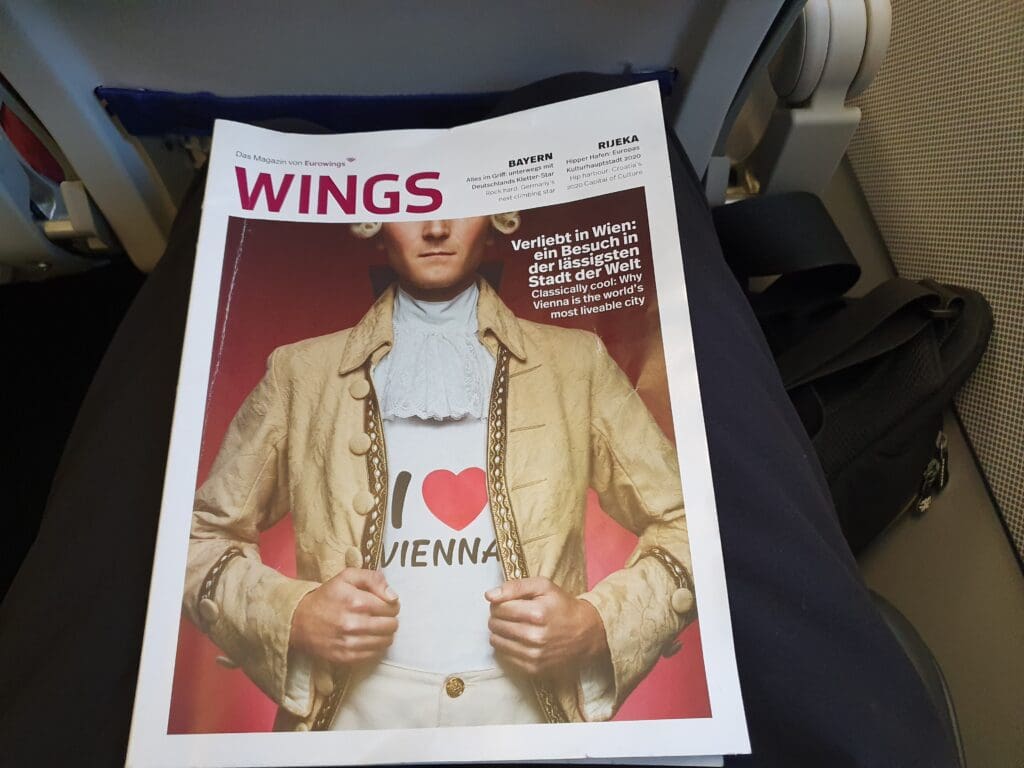
As time passed, passengers continued to stream onto the aircraft until this was nearly full and I was soon joined by two seatmates. On my previous flights with Eurowings between Britain and Germany, most passengers had taken the form of smartly dressed passengers presumably travelling for work. However, that morning, I would estimate that around half of those onboard took the form of more leisurely passengers. As soon as boarding had come to an end, the Purser made a brief announcement requesting all passengers to ensure that their luggage was correctly stowed before the Captain undertook their welcome announcement in German and English. During this, they thanked passengers for flying with Eurowings before advising that we could expect smooth flying conditions and an on time arrival in Dusseldorf. This was followed by a more detailed welcome announcement from the Purser which transitioned into the manual safety demonstration. Whilst the demonstration was underway, the Airbus jolted backwards before being pulled forward slightly as our two CFMI CFM56-5B4/P engines spooled into life with some hums, whirrs and vibrations.
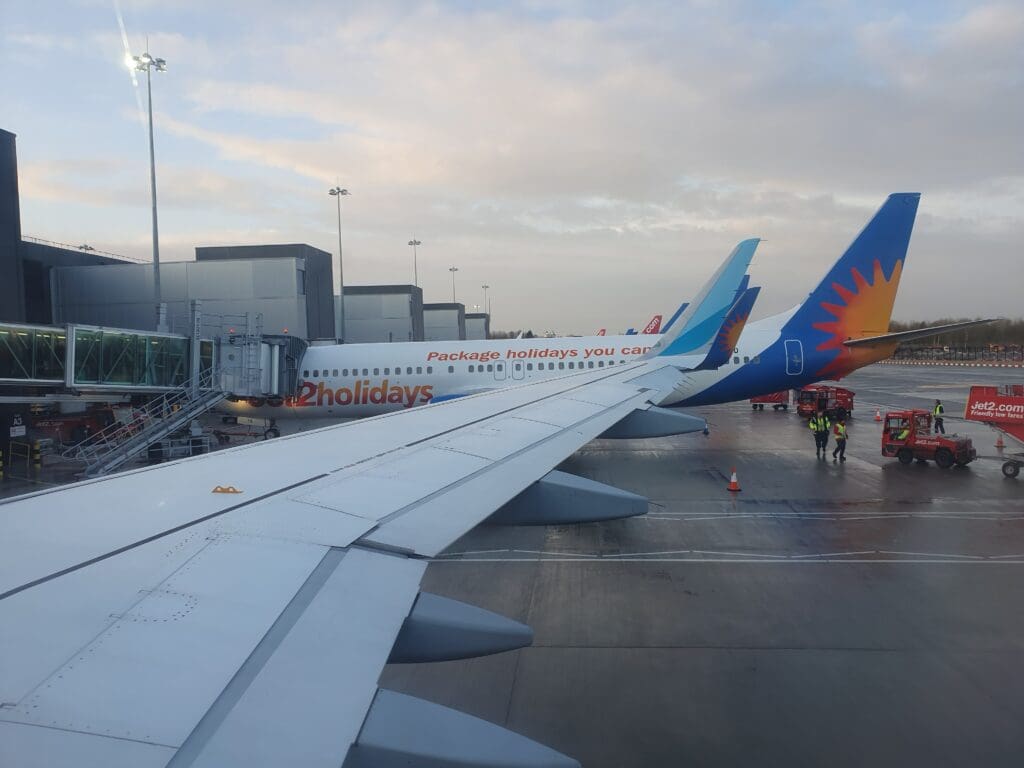

From our parking position, the Airbus made its way past the line of waiting Jet2 Boeing 737-800s, whilst inside the cabin refreshingly cool air began to emerge from the vents up above. Continuing onwards, the aircraft then made its way past the cargo area and remote stands where an ASL Airlines Ireland ATR 72 freighter operating on behalf of FedEx could be seen having a day’s rest before another night of flying. This was then followed by a pair of Thomas Cook Airlines UK Airbus A330s that had been in storage in Manchester since the demise of the company. As we headed away from the ramp, the Aviation Viewing Park came into view as did a Singapore Airlines Airbus A350 that had just touched down following an overnight slog across the Atlantic from Houston. As we approached Runway 23R, the Airbus held for a couple of minutes to allow for a brand new Aurigny ATR 72-600 to land before we crossed this and steamed onward to Runway 23L.
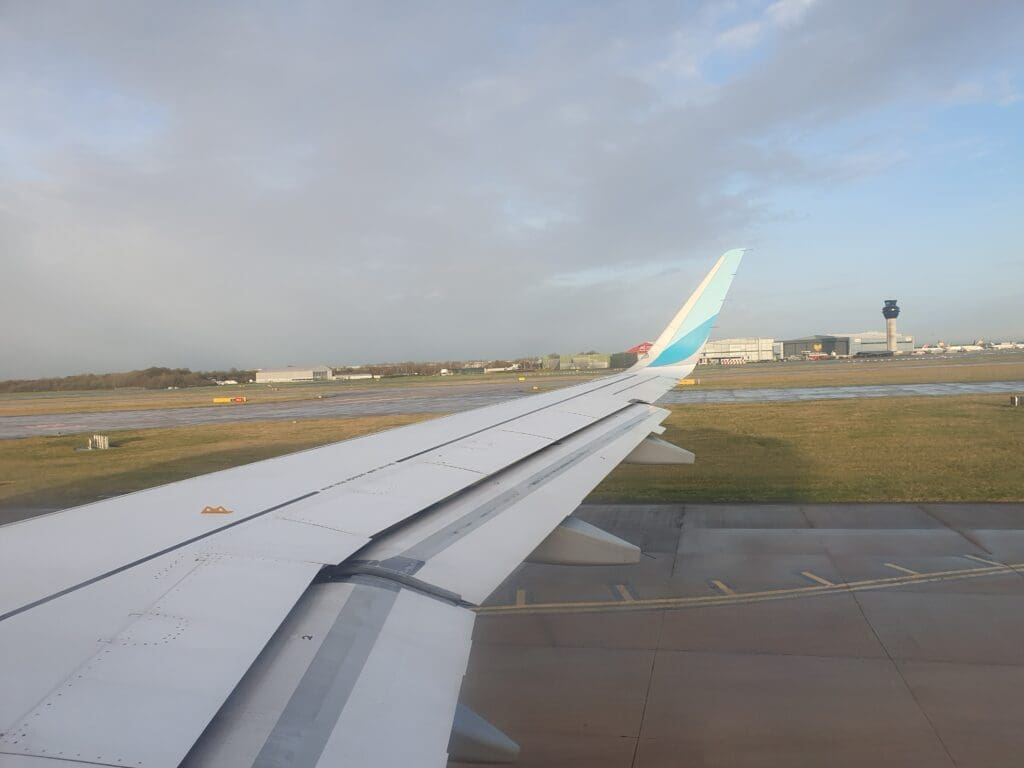
Without any holding, at 0825 the Airbus A320 taxied onto the runway and performed a gentle rolling takeoff, speeding over the Wilmslow Road tunnel before rotating up and soaring over the green fields of Cheshire. As we neared the town of Knutsford, the Airbus banked to the left and journeyed back towards Manchester, with the Tatton Park Estate coming into view, followed by the airport that we had just left behind. As we reached the snowy landscapes of the western fringes of the Peak District National Park, unfortunately, the clouds rolled in below and stole any decent views of the scenery below. Unfortunately, these failed to clear in time to catch a good view of Sheffield and instead parted just after passing over the city as we neared the Nottinghamshire town of Worksop.

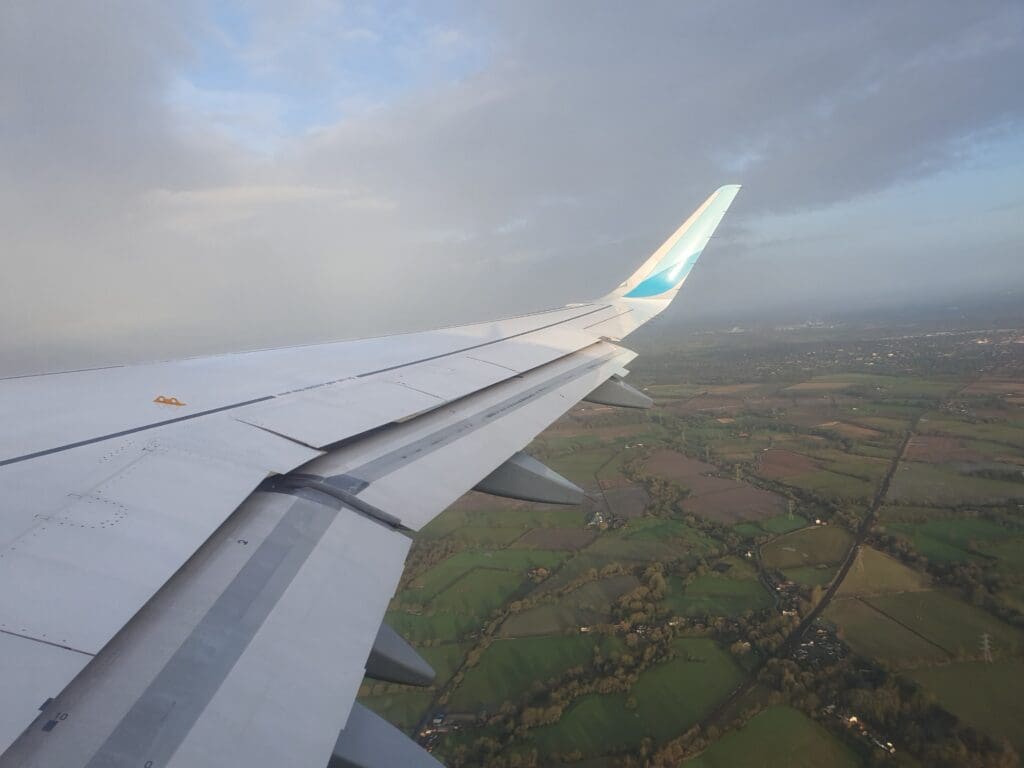

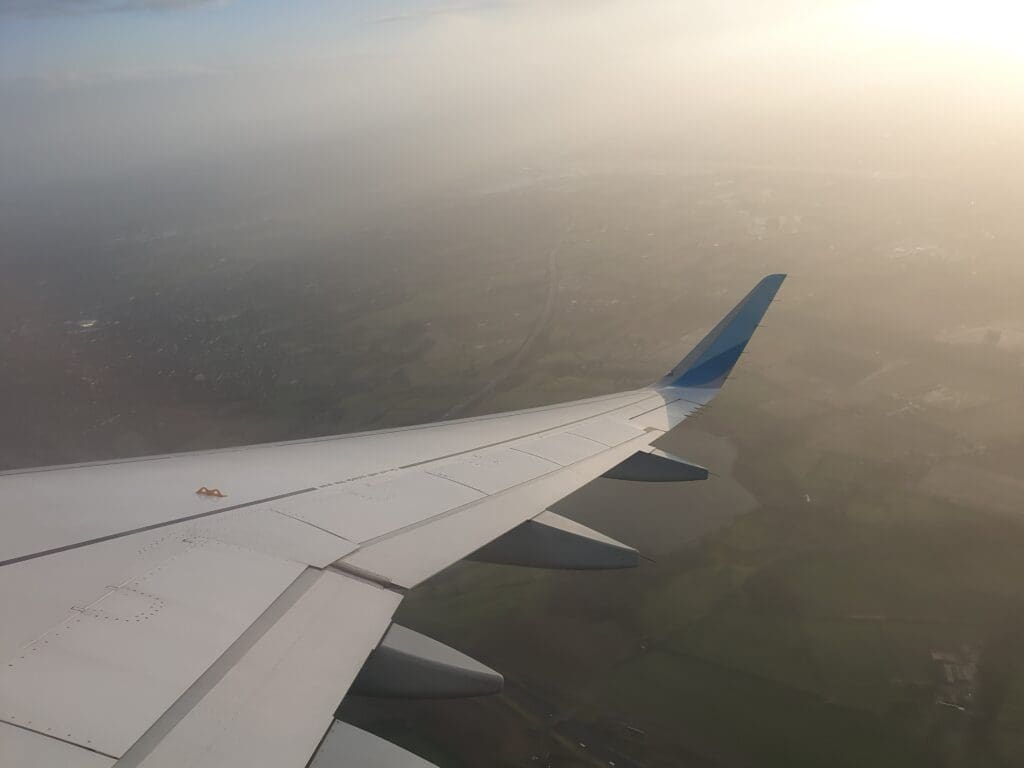
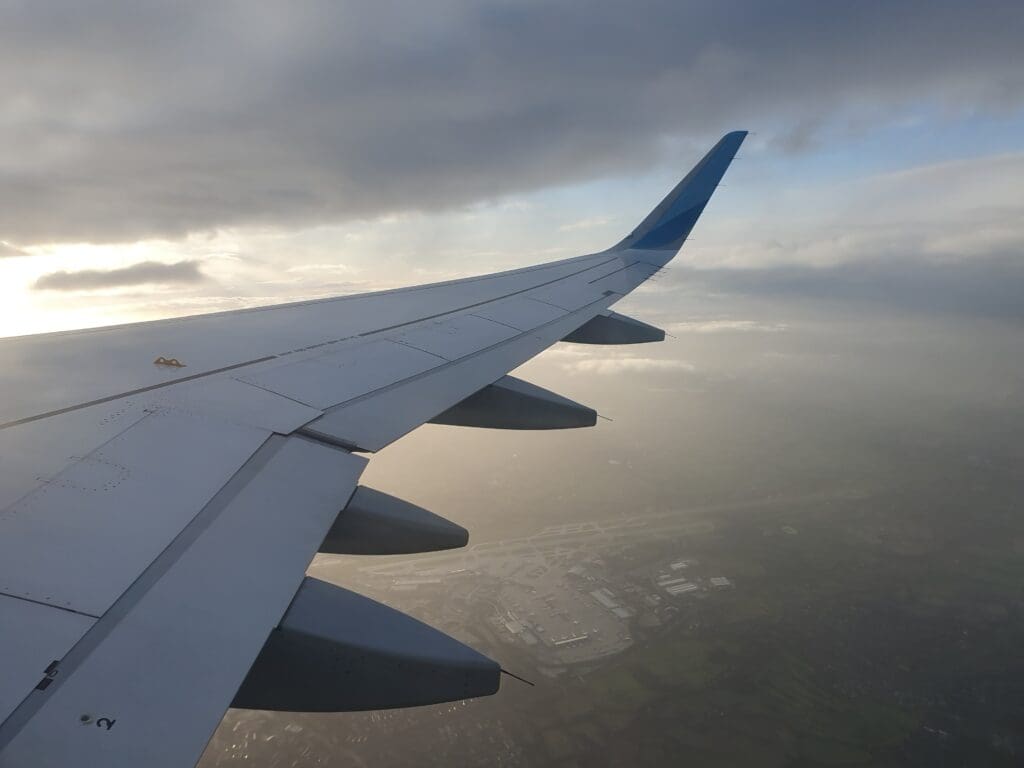
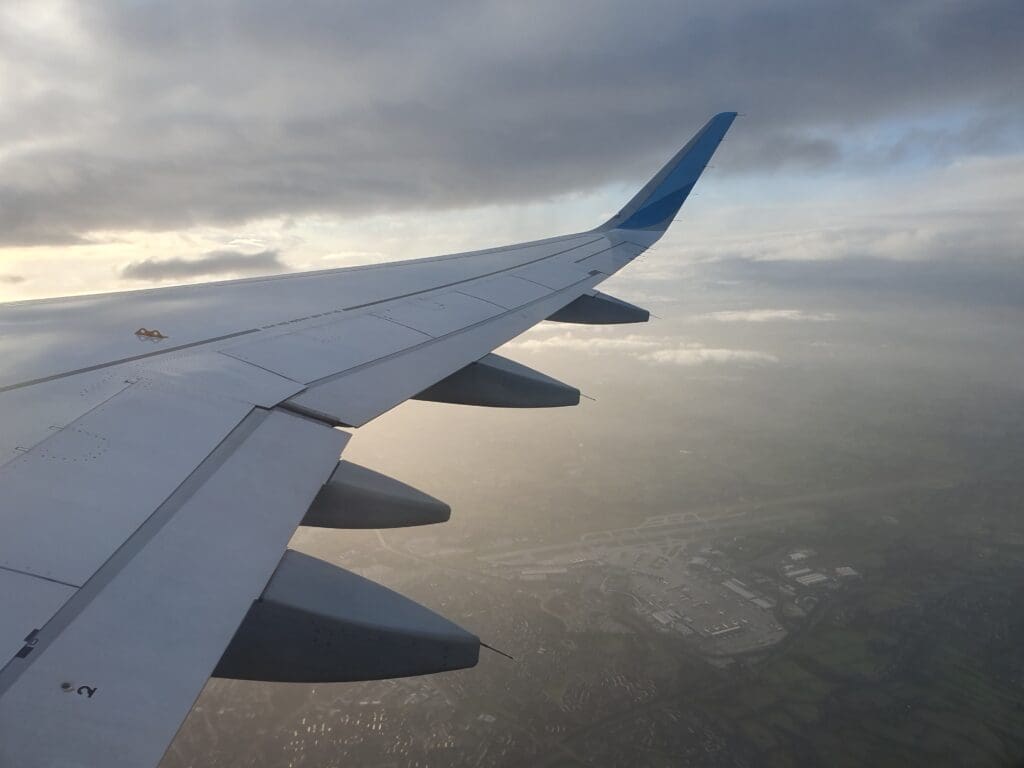
Inside the cabin, as we climbed three announcements rang through the cabin. The first detailed the usual seatbelt warning, the second related to the soon-to-commence buy-on-board service, and the third was a pre-recorded announcement advertising the Wings Connect wifi service. Focusing on the latter, whilst I had not intended to use this, I could not get my phone to connect to this. After this trio of announcements had rang out, one of the flight attendants walked down the aisle taking pre-orders for the hot options onboard that morning’s service. However, as far as I could tell, very few, if any, passengers seemed to fancy any of the more substantial hot items from the menu.
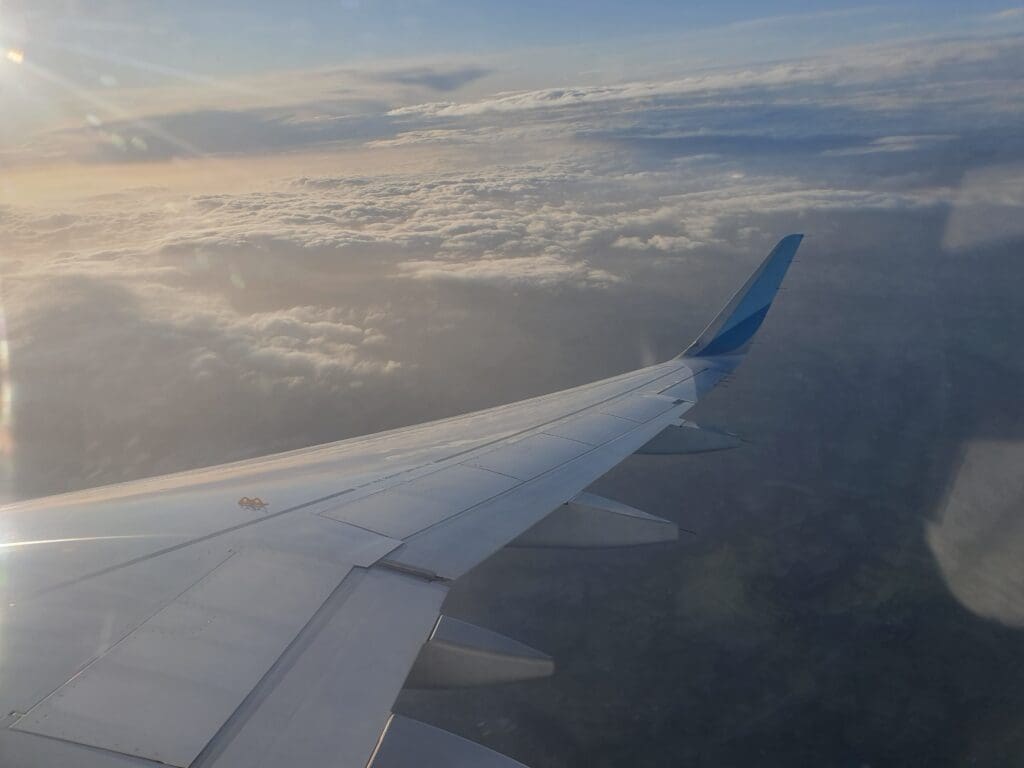
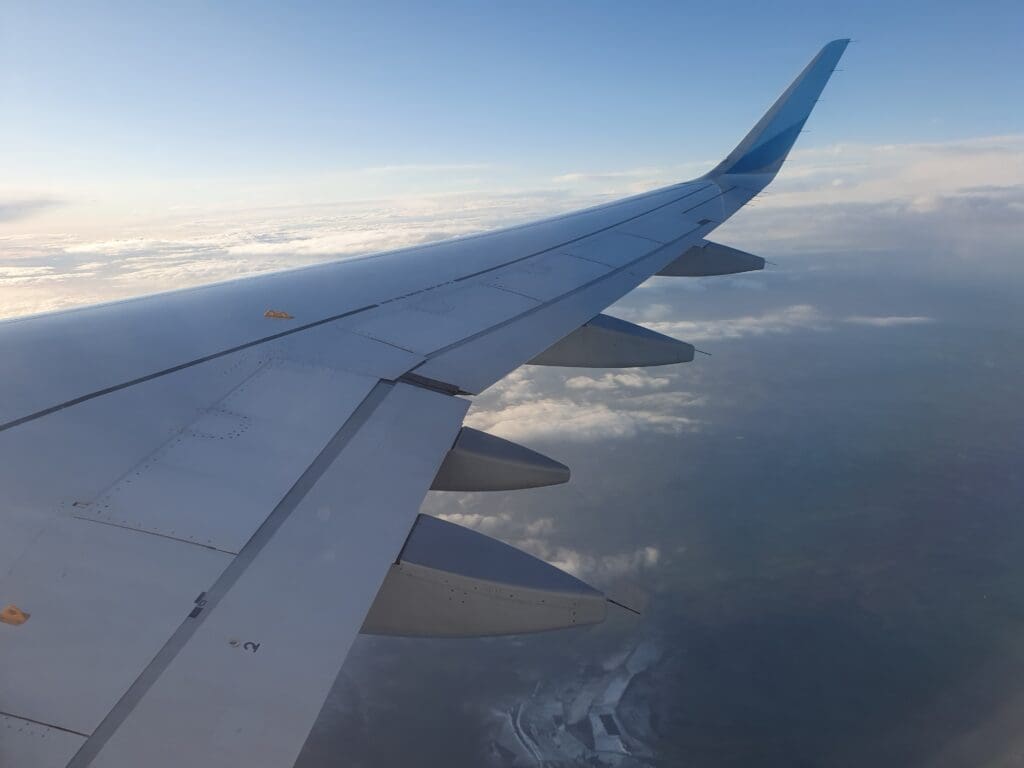
Turning back outside, after cutting across North Nottinghamshire, the aircraft soared over the flat lands of Lincolnshire where I spotted two active RAF bases in quick succession. The first was RAF Waddington, home to multiple squadrons operating a variety of aircraft and the second was the home of the RAF’s Eurofighter Typhoon operations, RAF Conningsby. Just under twenty mintues after taking off, the aircraft levelled off at 33,000 feet and crossed the coastline just to the south of Skegness, offering good views of the Wash and a couple of minutes of the North Norfolk coastline before clouds rolled in below.
Once upon a (very recent) time, those passengers travelling on Eurowings’ ‘Smart’ fare passengers received a complimentary snack on short and medium haul services. This usually consisted of a half-sandwich and a soft drink, similar to Lufthansa’s complimentary short haul offering. However, since then, complimentary food offerings on short and medium haul flights have been restricted to those in BIZclass. Thus, those in Economy seeking some inflight nourishment must turn to the Wings Bistro menu. Fortunately, this offers a wide selection of hot and cold sandwiches, snacks and drinks, which can be purchased individually or as part of a combination deal. However, as is to be expected, items come with the usual onboard mark up and are a little pricey. For example, a combo consisting of a cold sandwich, snack and drink would have set me back €8.00, whilst a coffee would have cost €3.50. Like the majority of passengers that morning, I opted not to purchase anything from the Wings Bistro and saved my second coffee of the day for Dusseldorf. During this service, the crew appeared to be polite, friendly and efficient, however, several passengers did seem to get caught out by Eurowings’ policy of only accepting payment in credit cards or Euros.
Slightly unusually for a low cost airline, those who book directly through Eurowings can download publications free of change – with the number of downloadable publications ranging from one (for those on the Basic fare) up to six (for those in BIZclass). Allowed to download three, I was pleased to find a diverse selection of magazines and newspapers offered on Eurowings’ Travel Media portal. Interestingly, not only did this host publications from Eurowings’ destinations, but also items from places such as Japan, New Zealand and Panama to name a few! Turning to Eurowings’ Wings magazine, this was neither the best nor worst inflight magazine that I have had the pleasure of flicking through. This featured the usual smorgasbord of travel articles, alongside plenty of advertisements.
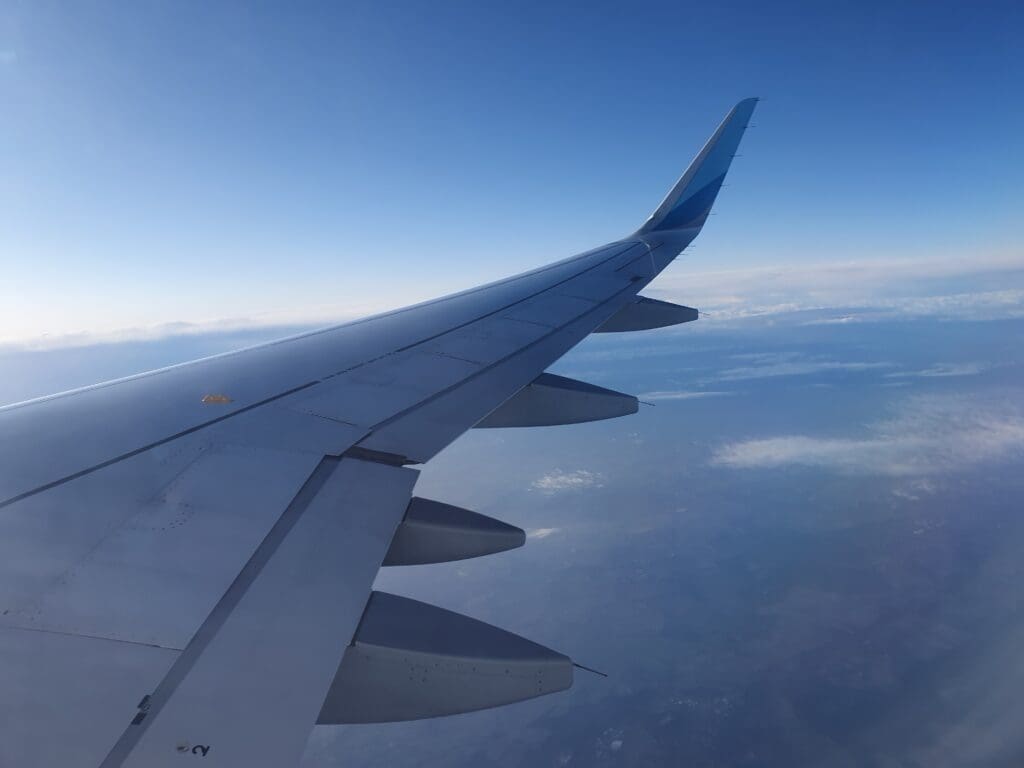
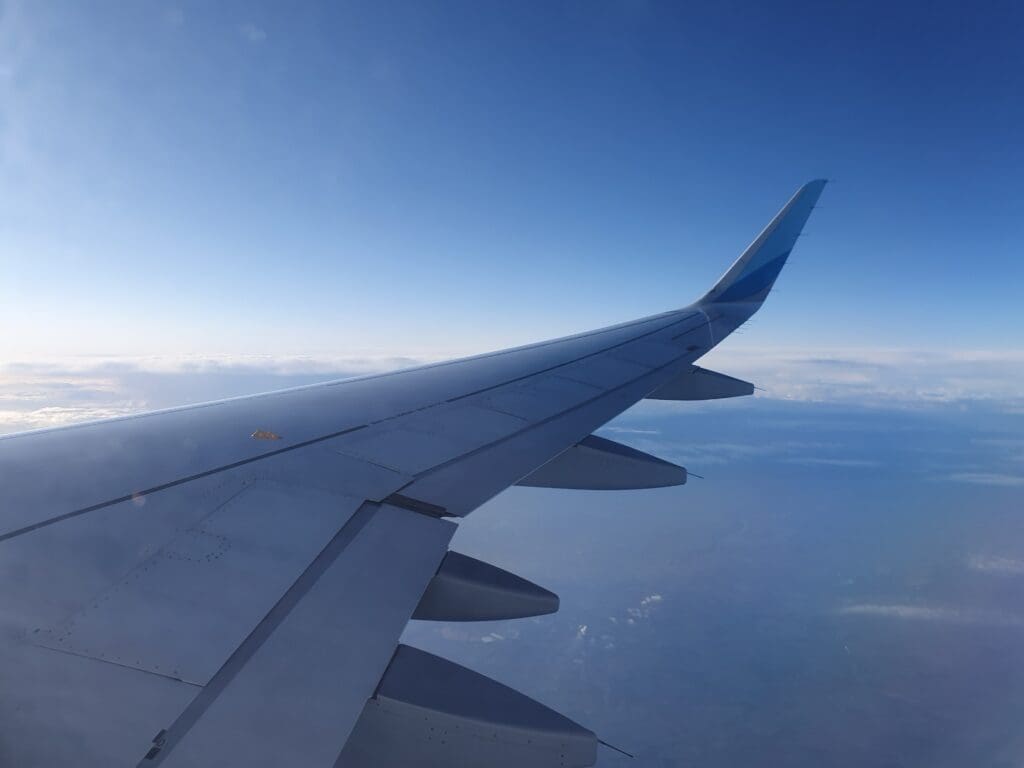
After 20 minutes in the cruise, the aircraft crossed over the Dutch coastline and it wasn’t long before the Airbus could be felt commencing its long descent into Dusseldorf. At 1005 German time, the Purser performed the first of multiple announcements made regarding our impending arrival before the crew took to the aisle and collected the remains of the service. Meanwhile, despite the Captain’s assurances of a smooth flight, somewhere over the Netherlands the Airbus sank into the clouds causing us to bump around a fair bit. Spending quite some time in the clouds, it was impossible to determine our location or altitude, and it was not until 1025 when the rainsoaked and mostly flat landscape of North Rhine-Westphalia came into view that I realised that we were nearing the end of our journey. As we sank lower, the flaps were partially extended and Essen Airfield came into view alongside the Ruhr River as we approached Dusseldorf Airport.

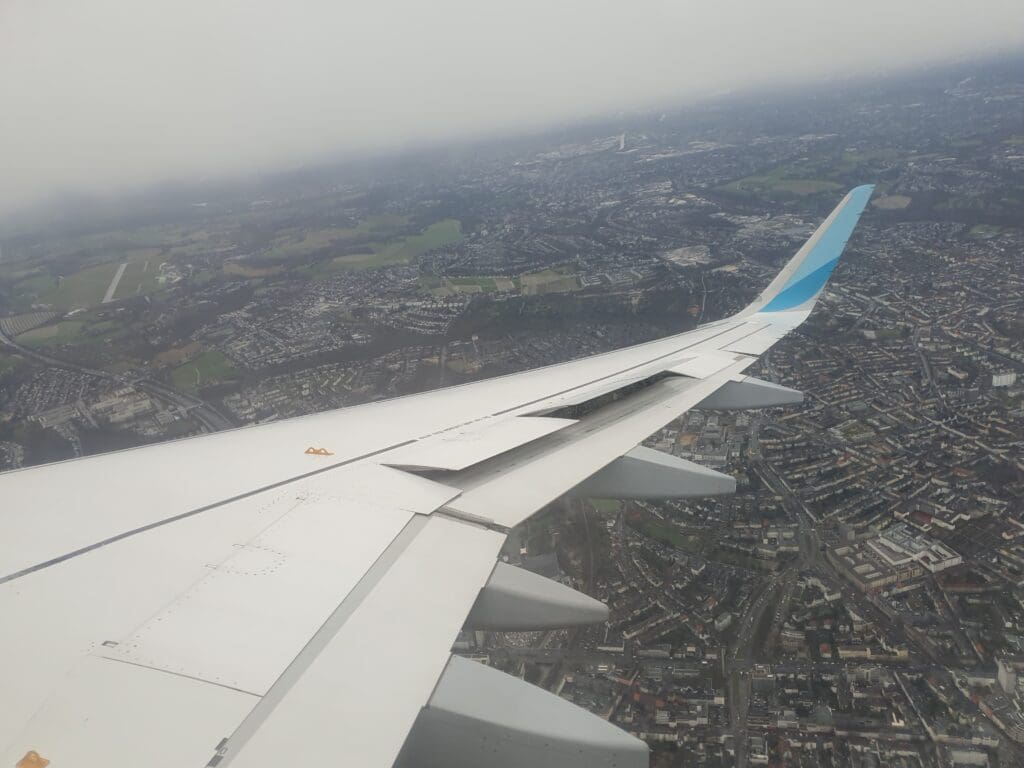
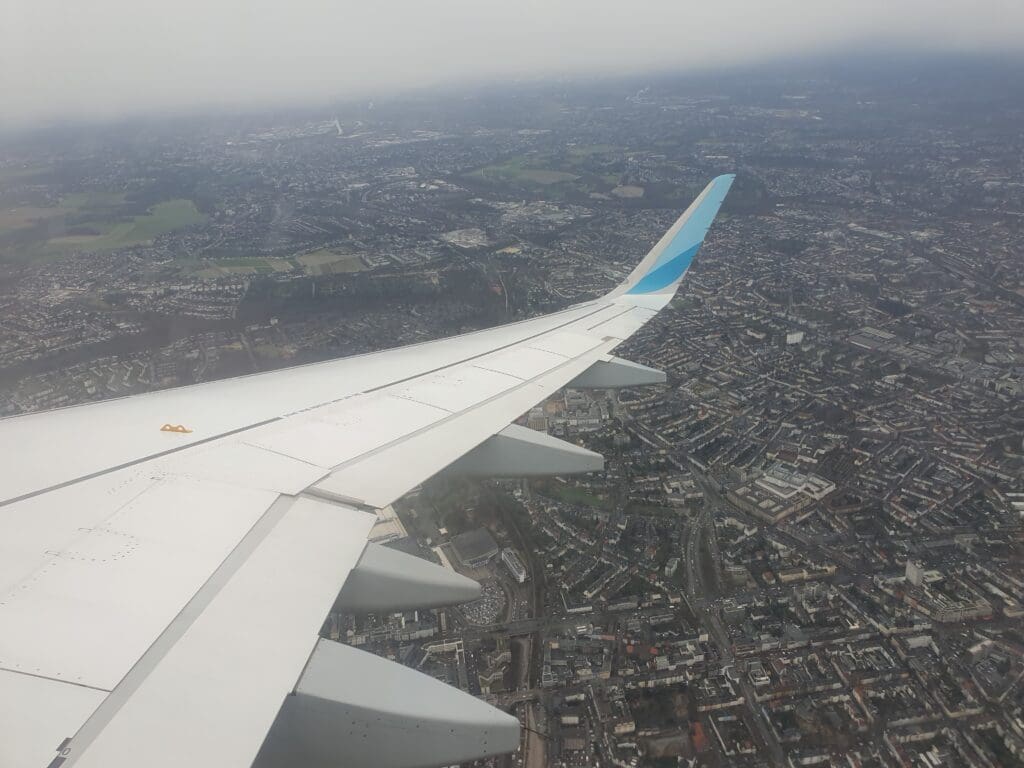
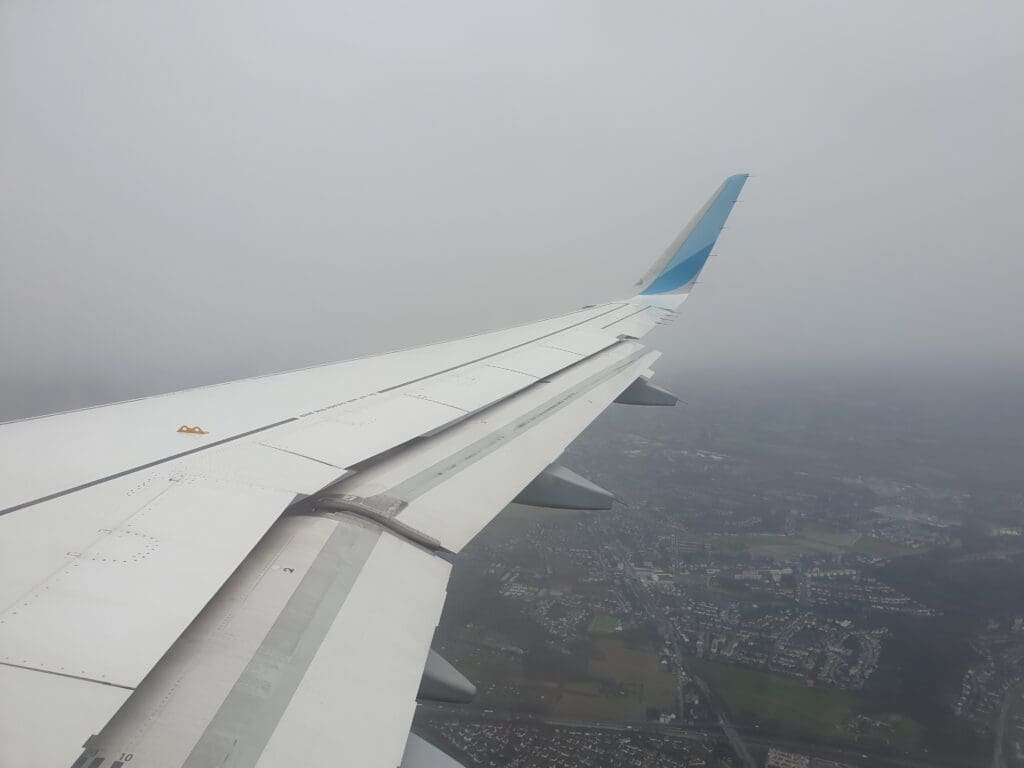
Admittedly, looking outside, it did not appear to be particularly great weather for a day out on Dusseldorf Airport’s open air observation deck, with rain lashing down all around! Furthermore, a reasonable wind was blowing which caused the aircraft to roll around and resulted in my seatmate grabbing onto the armrests until we had safely returned to Earth. Despite the turbulence on final approach, the Airbus made a smooth touchdown on Runway 23L which was followed by some light braking before we eventually vacated the runway near the end of this.

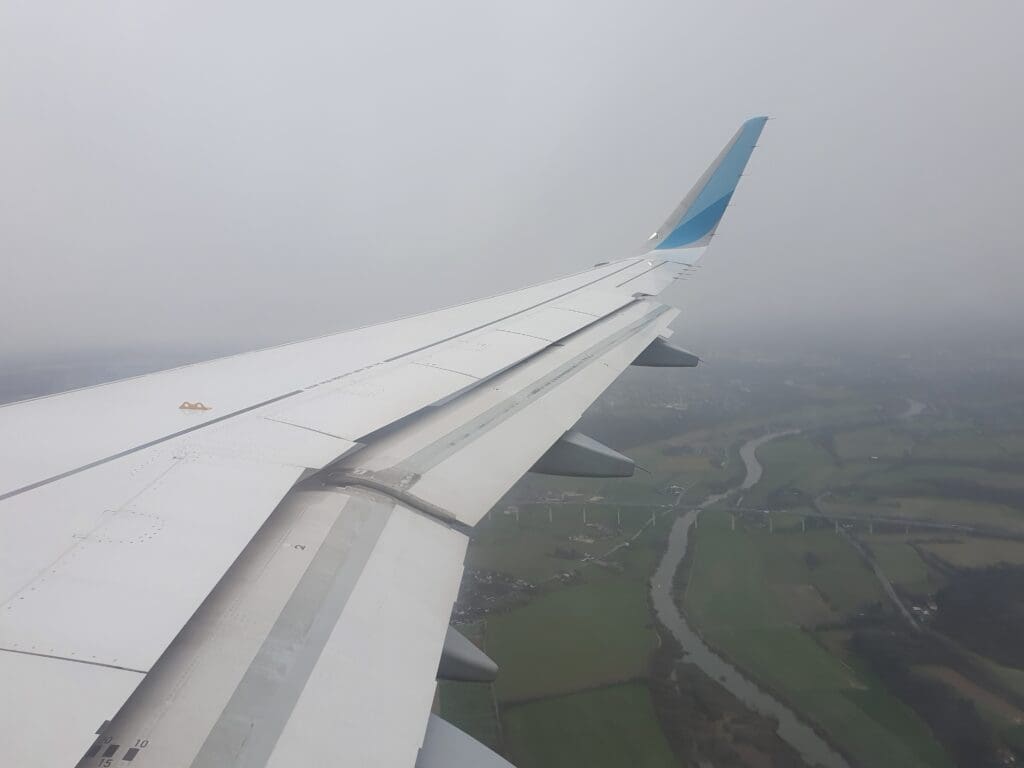
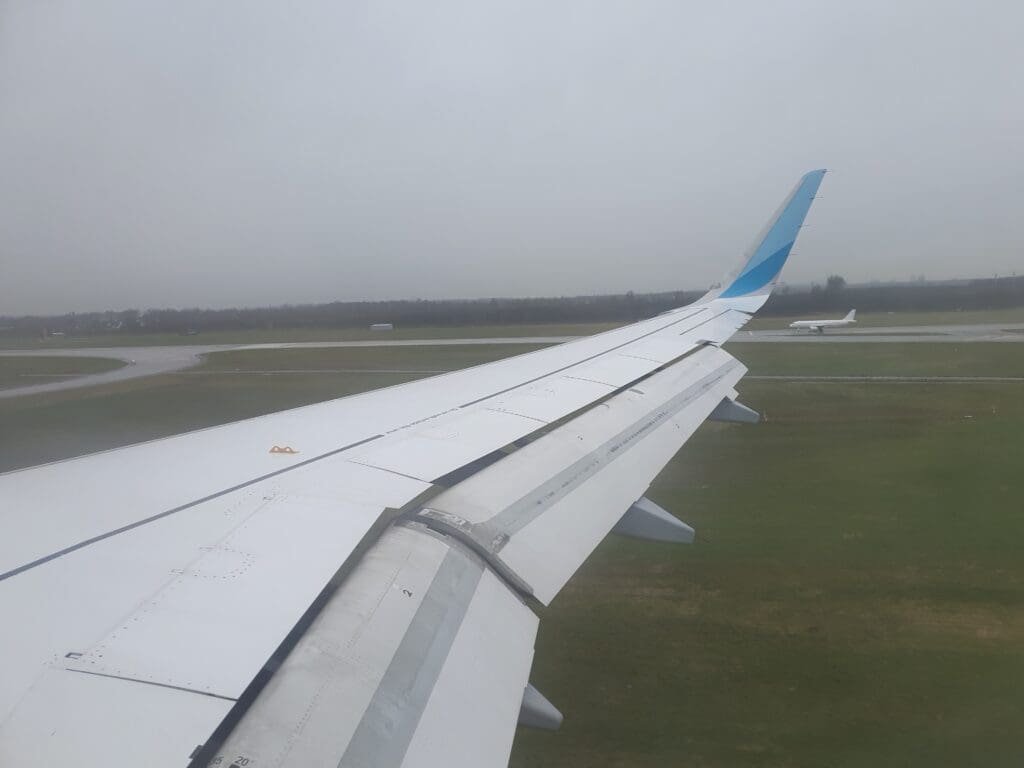

As we journeyed to a remote stand, it was clear that Eurowings rule the roost in Dusseldorf, and a mixture of the airline’s Airbus A319s, Airbus A320s and Airbus A330s could be seen lingering around waiting to head off to destinations both near and far. However, that morning, the most interesting and unexpected visitor came in the form of a Boeing 737-800 operated by Tajikistan’s flag carrier, Somon Air. This had arrived the previous day from Dushanbe via Tbilisi, and with Düsseldorf sitting off the carrier’s route network, I have no idea why this was visiting.
At our scheduled arrival time of 1035, the Airbus pulled in to Stand V47, slotting itself in between a SunExpress Boeing 737 and the aforementioned Tajik jet, before the engines spooled down. As is often the case, once we had come to a halt, many of those around me jumped up and scrambled to retrieve their bags. However, those who did so faced five minutes of waiting until the front and rear doors were opened and disembarkation commenced. Once this did begin, disembarkation was relatively quick and I found myself being one of the last to leave the aircraft, exiting the aircraft via the forward steps after quickly thanking the crew.
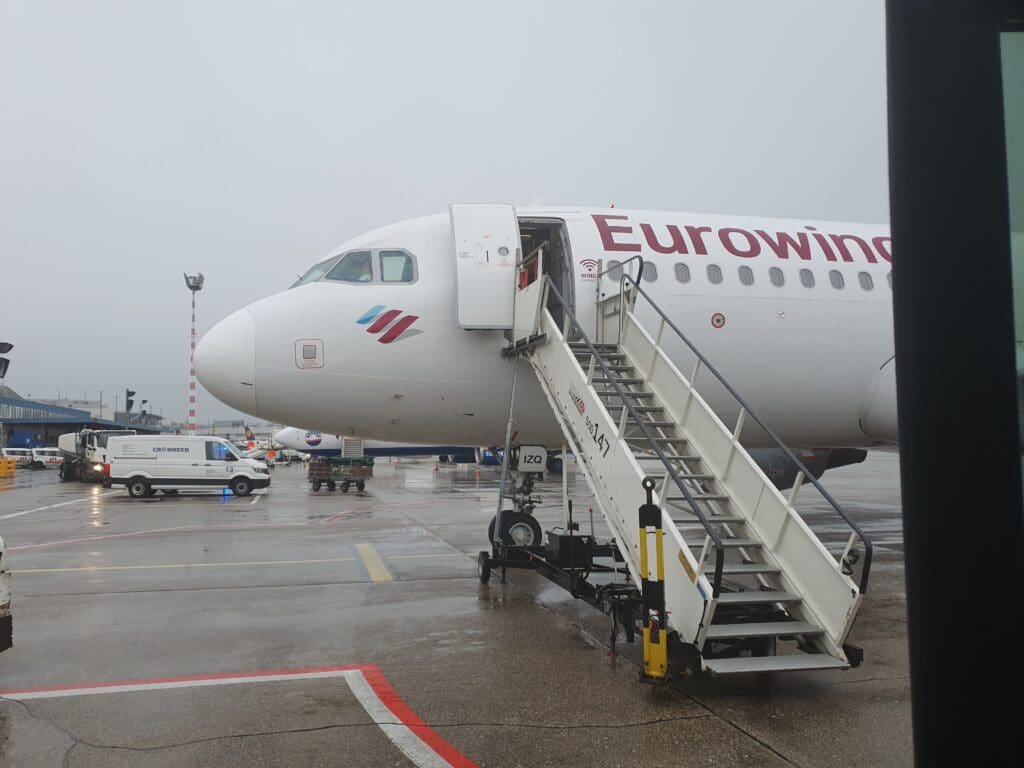
Being one of the last to board the bus, I squeezed into a tight space before the doors were closed and the bus pulled away as the Captain commenced the walk around in preparation for the aircraft’s next flight, with this taking the jet back across the North Sea to Newcastle. A few minutes later, the bus doors opened and we all piled into the ground floor level of the non-Schengen area of the terminal. From there, it was a quick journey up several flights of stairs to immigration where both manned booths and automated gates were available. Opting for the latter, I scanned my passport without any trouble before proceeding through the open terminal where both departures and arrivals mix. Following the signs for arrivals, I was taken down some more stairs to a reasonably sized baggage collection hall which doubles as a shrine to the car rental company Sixt. After arriving it took another ten minutes for the miniscule collection of the flight’s hold luggage to be delivered with these arriving at 1105. Seeing as my bag was one of the last to emerge, I was surprised to see that a reasonable number of bags had transitted in Manchester having arrived that morning after United’s flight from Newark. Once I picked up my bag, I headed straight out into arrivals before dropping off my bags at left luggage and heading up to the observation deck.
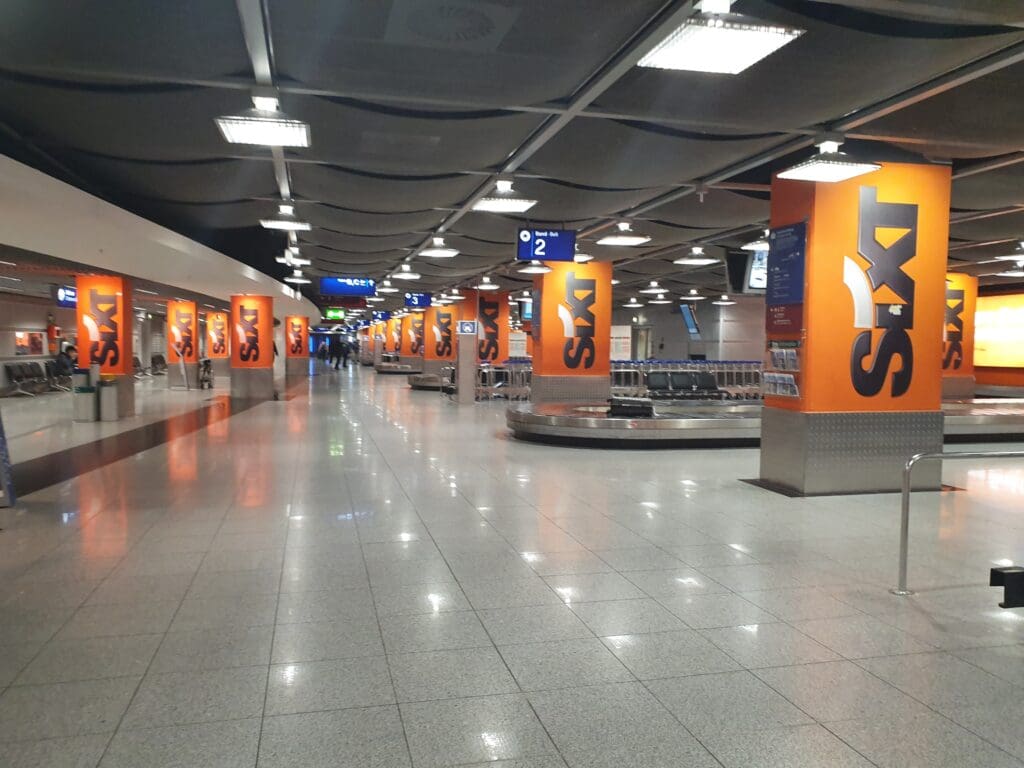
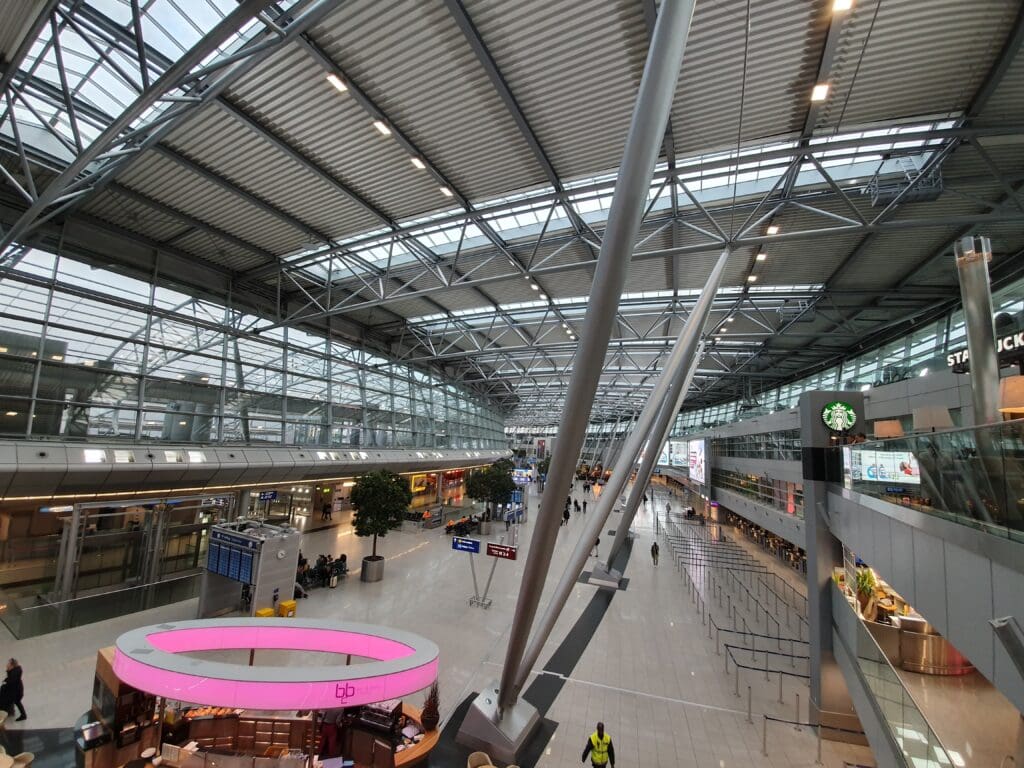
Summary
Eurowings delivered me to Dusseldorf almost on time and in one piece. The aircraft was not particularly comfortable, however this was tolerable for the short flight and I foudn the crew to be friendly and welcoming despite their early start! Therefore, from this experience, I can conclude that I would be open to flying with Eurowings again on short European services and perhaps even on one of their long haul flights too.

